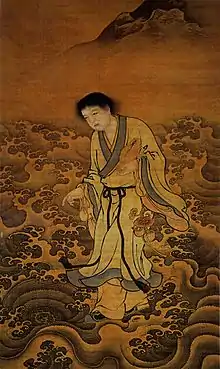Sennin
The Japanese term sennin is a loanword from Middle Chinese SenNyin 仙人 "immortal person", known also as xian "immortal; transcendent; genie; mage; djinn; sage; hermit" in Daoism.
Sennin is a common Japanese character name. For example, Ikkaku Sennin (一角仙人 "One-horned Immortal") was a Noh play by Komparu Zenpō (金春禅鳳, 1454–1520?). The Japanese legend of Gama Sennin (蝦蟇仙人 "Toad Immortal") is based upon Chinese Liu Hai, a fabled 10th-century alchemist who learned the secret of immortality from the Chan Chu ("Three-legged Money Toad").
In art

Sennin image was perpetuated in many Japanese legends, art, miniature sculpture (netsuke). It is the wooden netsuke, made in the 18th century. It represents a perplexed old man with one hand based on the curve of a snag, and the other hand is rubbing his head with concern. He is looking somewhere in the sky and tucked up the right leg. This position betrayed him as Sennin Tekkay, whose soul has found the second life in the body of the lame beggar. In shape the beggarly old man this legendary personality portrayed prominent carver of the early period Jobun.
See also
External links
- Ikkaku Sennin "The One-Horned Rishi", Arthur Waley, 1921, The Nō Plays of Japan
- Ikkaku Sennin, William Packard
- International Netsuke Society, official website
- INS Forums, discuss Sennin with the community
- Boris Filatov's Private Collection of Netsuke
- Netsuke: masterpieces from the Metropolitan Museum of Art, an exhibition catalog from The Metropolitan Museum of Art (fully available online as PDF), which contains many representations of Sennin
